| Historical Arab states and dynasties | ||||||||||||||||||||||||||||||||||||||||||||||||||||||||
|---|---|---|---|---|---|---|---|---|---|---|---|---|---|---|---|---|---|---|---|---|---|---|---|---|---|---|---|---|---|---|---|---|---|---|---|---|---|---|---|---|---|---|---|---|---|---|---|---|---|---|---|---|---|---|---|---|
 | ||||||||||||||||||||||||||||||||||||||||||||||||||||||||
Ancient Arab States
| ||||||||||||||||||||||||||||||||||||||||||||||||||||||||
Eastern Dynasties
| ||||||||||||||||||||||||||||||||||||||||||||||||||||||||
Western Dynasties
| ||||||||||||||||||||||||||||||||||||||||||||||||||||||||
Arabian Peninsula
| ||||||||||||||||||||||||||||||||||||||||||||||||||||||||
Current monarchies
| ||||||||||||||||||||||||||||||||||||||||||||||||||||||||
The Banu Tujib (Arabic : بنو تجيب) or Tujibids were an Arab dynasty that were appointed to govern Calatayud in 872, and in 886 were given Zaragoza. This they held as governors (sometimes only nominally, carrying out their own foreign policy) under the Umayyads. The collapse of the Caliphate of Córdoba allowed them to found the Taifa of Zaragoza, which they ruled from 1018 until they were expelled by a rival dynasty, the Banu Hud, in 1039. [1] [2] [3]

A dynasty is a sequence of rulers from the same family, usually in the context of a feudal or monarchical system, but sometimes also appearing in elective republics. Alternative terms for "dynasty" may include "house", "family" and "clan", among others. The longest-surviving dynasty in the world is the Imperial House of Japan, otherwise known as the Yamato dynasty, whose reign is traditionally dated to 660 BC.

Calatayud is a municipality in the Province of Zaragoza, within Aragón, Spain, lying on the river Jalón, in the midst of the Sistema Ibérico mountain range. It is the second-largest town in the province after the capital, Zaragoza, and the largest town in Aragón other than the three provincial capitals. It is the seat of the comarca of Calatayud.
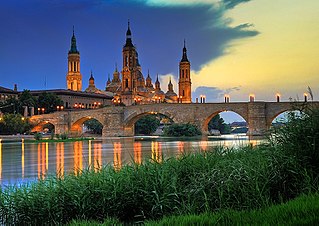
Zaragoza is the capital city of the Zaragoza province and of the autonomous community of Aragon, Spain. It lies by the Ebro river and its tributaries, the Huerva and the Gállego, roughly in the center of both Aragon and the Ebro basin.
In 934 Abd ar-Rahman III began a campaign in the north against Ramiro II of Leon and Muhammad ibn Hashim al-Tujibi, the governor of Zaragoza. The Tujibids had been governors of Zaragoza since the 800s. Refusing to submit to Abd ar-Rahman III, al-Tujibi formed an alliance with Ramiro II. [4] Christian and Muslim sources portray this campaign in different ways. According to Ibn Hayyan, after inconclusively confronting al-Tujibi on the Ebro, Abd ar-Rahman briefly forced the Kingdom of Pamplona into submission, ravaged Castile and Alava, and met Ramiro II in an inconclusive battle. [5] Ibn Hayyan, basing himself on Isa al-Razi, stated that al-Tujbi voluntarily sought an alliance with Ramiro II in order to avoid submitting to Abd ar-Rahman. According to Ibn Hayyan, Abd ar-Rahman negotiated a truce with Ramiro II in order to isolate al-Tujibi, and then forced al-Tujibi's surrender in 937. However, according to the Chronicle of Sampiro, in which al-Tujibi is called "Abohayha" (Abu Yahya), Ramiro II had attacked al-Tujibi and forced his submission, but once Abd ar-Rahman III arrived with his armies, al-Tujibi changed his allegiance to the Umayyads. In 939 Ramiro II met the combined Umayyad and Tujibid armies in the Battle of Simancas, defeating Abd ar-Rahman and capturing al-Tujibi in the process. [6] Ibn Hayyan agrees that the Battle of Simancas was a defeat for the caliph. [7]
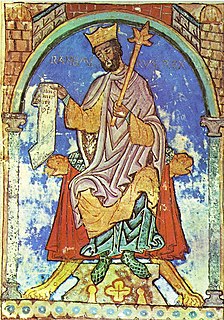
Ramiro II, son of Ordoño II, was a King of León from 931 until his death. Initially titular king only of a lesser part of the kingdom, he gained the crown of León after supplanting his brother Alfonso IV and cousin Alfonso Fróilaz in 931. The scant Anales castellanos primeros are a primary source for his reign.
Abū Marwān Ḥayyān ibn Khalaf ibn Ḥusayn ibn Ḥayyān al-Qurṭubī (987–1075), usually known as Ibn Hayyan, was a Muslim historian from Al-Andalus.
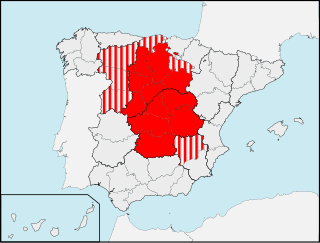
Castile is a historical region of Spain divided between Old Castile and New Castile. The area covers the modern autonomous communities of Cantabria and La Rioja with eastern Castile and León, Castile-La Mancha, and Madrid.
In 941, Abd ar-Rahman III sent Hisdai ben Isaac ben Shaprut, his secretary and doctor, to negotiate a treaty with Ramiro II. Ben Shaprut secured al-Tujibi's release in this treaty. [8] By 942, the Tujibids had been restored to the governorship of Zaragoza. Abd-ar-Rahman III sent Turkish slave soldiers from Cordoba to Zaragoza so that the Tujibids could deploy them against King Garcia Sanchez I of Navarre, who was allied to Ramiro II of Leon, Abd ar-Rahman's enemy. Ramiro II, in turn, sent forces to help Garcia Sanchez. However, Ibn Hayyan's history ends in that year, so these events are not known in as much detail as the previous campaigns of Abd ar-Rahman against Ramiro and al-Tujibi. [9]
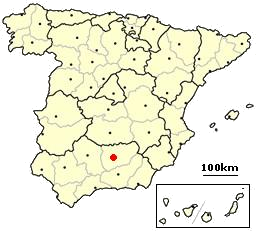
Hasdai ibn Shaprut born about 915 at Jaén, Spain; died about 970 at Córdoba, Andalusia, was a Jewish scholar, physician, diplomat, and patron of science.
After Almanzor had consolidated his power in 983, he formed an alliance with the Tujibids of Zaragoza to be his military support. However in 989 one of Almanzor's sons conspired with the Tujibids against his elder brother, Tujibid leader, Abd ar-Rahman ibn Mut'arrif, joining a pact that would see the family control the marches of the Caliphate, but Almanzor learned of the plot and executed Abd ar-Rahman al-Tujibi as well as his own son. The caliph then deprived the Tujibids of their authority in the Ebro area, but they were soon restored in Zaragoza. [10]

Abu ʿĀmir Muḥammad ibn ʿAbdullāh ibn Abi ʿĀmir, al-Ḥājib al-Manṣūr, better known as Almanzor, was for 24 years (978–1002) the de facto ruler of al Andalus under the Umayyad Caliphate of Córdoba. His rule marked the peak of power for al-Andalus. Some say that he claimed the title of a King, and was known as Al Malik Al Mansur.
The family reached the pinnacle of their power with the disintegration of the Caliphate of Córdoba. When in 1018, the Berber Ali ibn Hammud al-Nasir, had himself elected caliph in place of the ruling Umayyad dynasty, the Tujibid governor of Zaragoza, Al-Mundhir ibn Yahya declared independence and established the Taifa of Zaragoza, in which he would be succeeded by his son, Yahya ibn al-Mundhir, and grandson, Al-Mundhir ibn Yahya. Following the death of the latter in 1038/9, a cousin, Abd Allah ibn al-Hakam al-Tujibi, succeeded but was expelled from Zaragoza by a rival dynasty, the Banu Hud, and the Banu Tujib passed into obscurity.
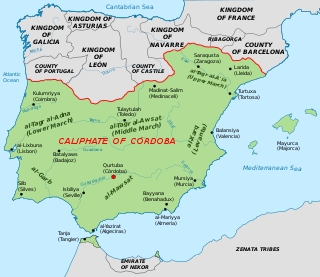
The Caliphate of Córdoba was a state in Islamic Iberia along with a part of North Africa ruled by the Umayyad dynasty. The state, with the capital in Córdoba, existed from 929 to 1031. The region was formerly dominated by the Umayyad Emirate of Córdoba (756–929). The period was characterized by an expansion of trade and culture, and saw the construction of masterpieces of al-Andalus architecture. In January 929, Abd ar-Rahman III proclaimed himself Caliph of Córdoba, replacing thus his original title of Emir of Córdoba. He was a member of the Umayyad dynasty, which had held the title of Emir of Córdoba since 756.
Ali ibn Hammud al-Nasir was the sixth Caliph of Córdoba from 1016 until his death. He was a member of the Hammudid dynasty of the Al-Andalus.
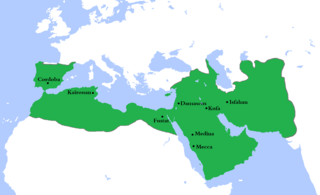
The Umayyad Caliphate, also spelt Omayyad, was the second of the four major caliphates established after the death of Muhammad. The caliphate was ruled by the Umayyad dynasty, hailing from Mecca. The third Caliph, Uthman ibn Affan, was a member of the Umayyad clan. The family established dynastic, hereditary rule with Muawiya ibn Abi Sufyan, long-time governor of Syria, who became the sixth Caliph after the end of the First Muslim Civil War in 661. After Mu'awiyah's death in 680, conflicts over the succession resulted in a Second Civil War and power eventually fell into the hands of Marwan I from another branch of the clan. Syria remained the Umayyads' main power base thereafter, and Damascus was their capital.









